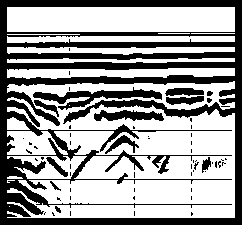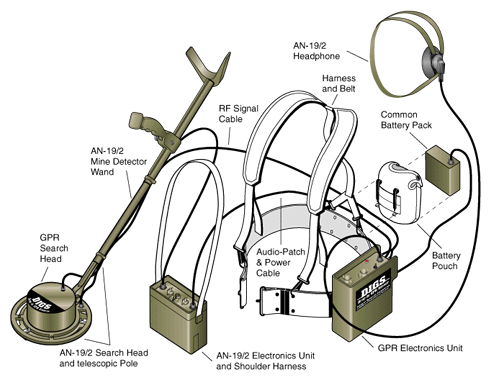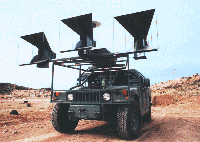

Introduction
The GPR technology has been used for about 15 years in civil engineering,
geology
and archeology for the detection of buried objects and soil study.
GPR works by emitting into the ground, through a wideband antenna, an
electromagnetic wave covering a large frequency band. This can be done
by using a
short pulse or a pure sine wave whose frequency is varied continuously
or by steps to cover the desired range. Reflections from the soil caused
by dielectric variations such as the presence of an object are measured.
By moving the antenna it is possible to
reconstruct an image representing a vertical slice of the soil..
A wide frequency band is needed to achieve a good resolution, but since
higher
frequencies do not propagate well, the chosen range is always a tradeoff
between
resolution and penetration depth. For antipersonnel mines, a center
frequency of 1 to 2 GHz seems to be a good choice for most types of soil.
The GPR is able to detect non-metallic materials as long as their dielectric
characteristics are sufficiently different from the surrounding media.
It must be noticed that systems used in civil applications do not have
any automatic
recognition algorithms implemented; this is therefore the domain where
most of the
work has to be done, to allow the use of this technology for mine detection.
GPR basic principles
Basically, GPR systems work by emitting a short electromagnetic pulse
in the ground
through a wideband antenna. Reflections from the ground are then measured
to form a vector. The displacement of the antenna allows to build an image
by displaying
successive vectors side by side.
Any dielectric discontinuity in a propagating media, as for example
the presence of an object, will cause a reflection; its intensity will
be higher with increasing difference
between the dielectric coefficients. Typical soils permittivity vary
from about 4 to 40,
wet soils having a higher permittivity than dry ones (water has a permittivity
of 80).
Permittivity of plastic objects is in the range of 2 to 6.
Typical pulses have a width of the order of a nanosecond or less, with
rise time of
some hundred of picoseconds, which correspond to a frequency spectrum
of some
hundreds of MHz to 1-2 GHz.
High frequencies are needed to achieve a good spatial resolution, but
penetration
depth of electric fields being inversely proportional to the frequency,
too high
frequencies are useless after some centimeters. Hence the choice of
the frequency
range is a tradeoff between resolution and penetration depth. A system
working with
an antenna whose center frequency is at 1 GHz is considered by experts
as being a good compromise for anti-personnal mines, allowing to work at
depths of 50 cm to 1
m in most soils with a resolution of the order of some centimeters.
Penetration depth will also depend on the nature of the soil which have
different
attenuation. For example desert sand has an attenuation of about 1
dB/m for 1 GHz
frequency, clay having attenuation of 100 dB/m at the same frequency.
The reflected wave is sampled and digitized by an A/D converter. The
region of
interest is quite short, for example in sand, 1 meter depth corresponding
to about 20
ns. Typically 512 points are taken through the region of interest,
which correspond to
a sampling rate far too high for standard converters. The solution
is to repeat the
generation of the pulse (typical repetition rates range from some tens
of KHz to 1
MHz) and to acquire only one sample in each reflected wave, the sampling
time being shifted by some tens of ps for each pulse. This allows to use
standard and relatively
low cost converters.
By moving the antenna along a line and taking regularly spaced acquisitions,
it is
possible to construct an image representing a vertical slice of the
ground. These
images show hyperbolas whose apex is located at the objects positions.
These
hyperbolas result from the fact that antennas have a certain aperture
and capture all
reflections coming from a cone-shaped area below them. These hyperbolas
can be
focused by software (migration algorithms) to obtain the real image
of the objects.
 Typical GPR Output
Typical GPR Output
An alternative to the most used (real pulse) GPR is to work with so
called synthetic
pulses. The response to pure sine waves of discrete frequencies of
the spectrum of a theoretical pulse are measured. Using the appropriate
signal processing algorithms
the response to the theoretical pulse can be reconstructed.
Research studies:

 DIGS - Principles of Operation
DIGS - Principles of Operation

DIGS was developed for the US Army and meant to be commercialized soon.


The system uses a stepped continuous wave (cw) signal, with three horn
antennas. The stepped cw approach, going from 0.5 to 4 GHz, allows the
system to excite the resonant frequencies of all mine targets. This stepped
cw approach creates the ability to obtain detectable signals from all targets,
as well as the ability to identify the targets based on resonant frequencies.
Of the
three horns, the middle horn transmits, while the outside two receive,
which allows for azimuth detection, as well as range determination and
identification. The result is a system capable of detecting, locating,
and identifying targets at safe stand-off ranges of up to 100 feet. The
total radiated power is 1 watt,
although there are plans to increase the power to 10 watts.
|
|
 |